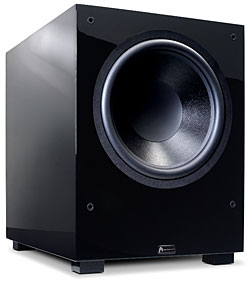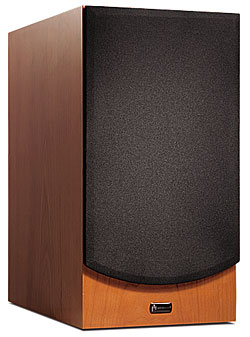Aperion Audio Intimus 633-T Surround Speaker System
 Like it or not, the Internet has spawned a number of audio and video companies that deal directly with the public. There are no traditional, so-called brick-and-mortar shops involved. The obvious advantage of such a direct purchase is price. The disadvantage is the lack of personal service, including demonstration facilities.
Like it or not, the Internet has spawned a number of audio and video companies that deal directly with the public. There are no traditional, so-called brick-and-mortar shops involved. The obvious advantage of such a direct purchase is price. The disadvantage is the lack of personal service, including demonstration facilities.
Much as we at UAV believe in the usefulness and reliability of our reviews, we have always held that you should audition products for yourself before making a final decision. This is especially important with loudspeakers. But perhaps even more important is auditioning them in your own environment. Even a good in-store demonstration will not tell you exactly what a set of speakers will sound like in your own room. And while many high-end, specialty AV shops will let you exchange speakers you didn't like when you got them home (but don't assume they will!), it's unlikely that Larry's World-Famous Audio Shoppe will give you a full refund so you can go downtown to Handy Andy's Reliable Audio/Video to check out your second choice (which, of course, Larry doesn't carry).
Enter companies like Aperion Audio. Riding the wave of rapidly growing Internet commerce, Aperion has grown substantially since launching their web operation just a few years ago. They now offer not only the compact systems they've become well known for, but two new floor-standing designs as well. One of them, the 633-T, anchors the $2475 system reviewed here.
How does Aperion get around the no-demonstration problem? By offering a 30-day, risk-free, in-home audition. Shipping is included—both ways, if needed. Listen to the system in your own room, on your own schedule, with your own components. If you don't like it, they'll take it back. Based on what I heard, however, it's unlikely you'll be calling FedEx for a pickup.
Description
My positive impressions of the Aperion speakers started as soon as I opened the box. Each speaker is swathed in a soft velveteen bag. On all the models I tested removing the bag revealed a quality of fit-and-finish that compares favorably with many speakers selling for three times the price. I requested the glossy, piano-black finish on all the speakers except for the bookshelf 632-LRs (used here for surrounds). I asked that those be in Medium Cherry so I could check out both available finishes. The black is incredibly rich, though it will show fingerprints and develop hairline scratches (barely visible and only in direct lighting) with overly vigorous dusting and polishing. There's nothing at all wrong with the matte-finished cherry, either; it's real wood veneer, with the grain perfectly matched at the corners. But it doesn't look anywhere near as expensive as the black (there's no price premium for the black finish).
A pair of the floor-standing Intimus 633-Ts served here for the front left and right channels. Under the removable grille (I did all of my listening sans grilles) you'll find three drivers and a large port. The latter is not only flared on the front, but on the inside as well (as I discovered by reaching my hand in there, which I don't recommend as I nearly didn't get it back out again!). I never heard port noise complaints from any of the speakers.
The two woofers are driven together through the bass and midrange. The woofer cones are a lightweight composite material, and the drivers have been designed for extra long excursion. The silk-dome tweeter, which uses a compact, neodymium magnet, is mounted very close to the top of the cabinet edge above it and the woofer below. (Neodymium is a very powerful magnetic material widely used in speaker drivers that must fit into tight spaces.)
 Around back is a single pair of five-way binding posts (no bi-wiring here). There are threaded inserts on the bottom of the cabinet for spikes, but the spikes provided are not sharp enough to penetrate most carpets (cone-shaped spikes rarely will).
Around back is a single pair of five-way binding posts (no bi-wiring here). There are threaded inserts on the bottom of the cabinet for spikes, but the spikes provided are not sharp enough to penetrate most carpets (cone-shaped spikes rarely will).
The Intimus 632-LR bookshelf speaker moves its port around back, but apart from that it is similar to its big brother in many ways. Its single woofer and smaller cabinet results in a less extended bottom end, but the drivers themselves appear to be identical to those in the 633-T.
The Intimus 533-VAC center channel is the most complicated of the group. It's a three-way design of the type I've always favored for a horizontally-configured, center channel speaker—with the midrange and tweeter mounted vertically, flanked by what appear to be woofers on either side (more on that in a bit). This is the best recipe (short of a center speaker identical to the left and right—an alternative that is seldom practical) to insure a reasonably uniform off-axis frequency response. At $280, the 533-VAC is also one of the least expensive center channel speakers to employ such a design.
The tweeter in the 533-VAC appears to be the same unit used in the other Aperion speakers. The 4" midrange has a polypropylene cone, and while its crossover frequencies are not specified (nor are those of the other speakers), Aperion's website does state that it operates from 900-2500Hz.
One of the two "woofers" flanking the 533-VAC's mid-tweeter pair is actually a passive radiator, performing the same function as a port for the active woofer driver. Both the woofer and the passive radiator have paper cones treated with a polyvinyl acetate compound. Like the other full-range speakers in the system, the 533-VAC is shielded.
Aperion also employs a (trademarked) HD-X crossover topology in all of their speakers, which is claimed to produce uniform impedance across the frequency range.
The Intimus S-12 subwoofer is a large but not excessively heavy design, despite its claimed 1"-thick high-density fiberboard (HDF, not MDF) walls and internal bracing. It has both high (speaker) level and line-level inputs and outputs. Of the line-level outputs, Aperion's website states: "The line output on your sub is able to send a bass-managed signal back to your amplifier." Why you would want to send a signal back to your amplifier I can't imagine. Perhaps what it means is that the line-level output may be used to daisy-chain more than one subwoofer (that is, the output of the first subwoofer is sent to the amplifier in another subwoofer), provided that such a signal is sent from your amplifier to the first woofer in the chain to begin with.
 The S-12 also provides continuously variable low-pass crossover frequencies from 40-160Hz (but no crossover bypass switch; if your receiver is performing the crossover function, you'll want to set the crossover on the S-12 to its 160Hz maximum). There's also a continuously variable phase adjustment, a volume control, and an auto-sensing turn-on switch (which also provides both Off and always On options).
The S-12 also provides continuously variable low-pass crossover frequencies from 40-160Hz (but no crossover bypass switch; if your receiver is performing the crossover function, you'll want to set the crossover on the S-12 to its 160Hz maximum). There's also a continuously variable phase adjustment, a volume control, and an auto-sensing turn-on switch (which also provides both Off and always On options).
Intelligence Inside?
The quality visible on the outside of the Aperion speakers was so intriguing that I became curious to see if the inside lived up to its end of the bargain. Is there more here than just a pretty face?





























































